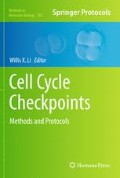Abstract
The Ataxia telangiectasia-mutated (ATM) and the ATM-Rad3-related (ATR) kinases are master regulators of the DNA damage-signaling pathways that respond to a wide variety of DNA damage. In this chapter, we describe an in vitro biochemical assay to study the activation of ATM and ATR by double-stranded DNA breaks (DSBs) (Shiotani and Zou, 2009, Mol Cell 33, 547–58). In this assay, DNA fragments with different structural features are used to activate ATM and ATR in human cell extracts, and the activation of ATM and ATR is monitored by the phosphorylation of specific ATM and ATR substrates. Importantly, in this assay both ATM and ATR are activated in a DNA structure-regulated manner, providing a useful tool to characterize the DNA structural determinants for their activation. The four primary steps of this assay are as follows: (1) preparation of nuclear extracts from cultured human cells; (2) generation of various DNA fragments using DNA oligonucleotides or plasmids; (3) incubation of DNA fragments in extracts; (4) analysis of the phosphorylation of specific ATM or ATR substrates.
Access this chapter
Tax calculation will be finalised at checkout
Purchases are for personal use only
References
Harper, J. W., and Elledge, S. J. (2007) The DNA damage response: ten years after. Mol Cell 28, 7309–45.
Jackson, S. P., and Bartek, J. (2009) The DNA-damage response in human biology and disease. Nature 461, 1071–8.
Zhou, B. B., and Elledge, S. J. (2000) The DNA damage response: putting checkpoints in perspective. Nature 408, 433–9.
Zou, L. (2007) Building of a trigger of ATR-mediated DNA damage response. Genes Dev 21, 879–85.
Cimprich, K. A., and Cortez, D. (2008) ATR: an essential regulator of genome integrity. Nat Rev Mol Cell Biol 9, 616–27.
Lee, J. H., and Paull, T. T. (2005) ATM activation by DNA double-strand breaks through the Mre11-Rad50-Nbs1 complex. Science 308, 551–4.
Bakkenist, C. J., and Kastan, M. B. (2003) DNA damage activates ATM through intermolecular autophosphorylation and dimer dissociation. Nature 421, 499–506.
Shiotani, B., and Zou, L. (2009) ATR signaling at a glance. J Cell Sci 122, 301–4.
Zou, L., and Elledge, S. J. (2003) Sensing DNA damage through ATRIP recognition of RPA-ssDNA complexes. Science 300, 1542–8.
Ellison, V., and Stillman, B. (2003) Biochemical characterizations of DNA damage checkpoint complexes: clamp loader and clamp complexes with specificity for 5' recessed DNA. PLoS Biol. 1, e33.
Zou, L., Liu, D., and Elledge, S. J. (2003) Replication protein A-mediated recruitment and activation of Rad17 complexes. Proc Natl Acad Sci USA 100, 13827–32.
Kumagai, A., Lee, J., Yoo, H. Y., and Dunphy, W. G. (2006) TopBP1 activates the ATR-ATRIP complex. Cell 124, 943–55.
Delacroix, S., Wagner, J. M., Kobayashi, M., Yamamoto, K., and Karnitz, L. M. (2007) The Rad9-Hus1-Rad1 (9-1-1) clamp activates checkpoint signaling via TopBP1. Genes Dev 21, 1472–7.
Shiotani, B., and Zou, L. (2009) Single-stranded DNA orchestrates an ATM-to-ATR switch at DNA breaks. Mol Cell 33, 547–58.
Acknowledgments
This work is supported by a NIH grant (GM076288) to Lee Zou. Bunsyo Shiotani was partly supported by a fellowship form the Tosteson Foundation.
Author information
Authors and Affiliations
Corresponding author
Editor information
Editors and Affiliations
Rights and permissions
Copyright information
© 2011 Springer Science+Business Media, LLC
About this protocol
Cite this protocol
Shiotani, B., Zou, L. (2011). A Human Cell Extract-Based Assay for the Activation of ATM and ATR Checkpoint Kinases. In: Li, W. (eds) Cell Cycle Checkpoints. Methods in Molecular Biology, vol 782. Humana Press. https://doi.org/10.1007/978-1-61779-273-1_13
Download citation
DOI: https://doi.org/10.1007/978-1-61779-273-1_13
Published:
Publisher Name: Humana Press
Print ISBN: 978-1-61779-272-4
Online ISBN: 978-1-61779-273-1
eBook Packages: Springer Protocols

